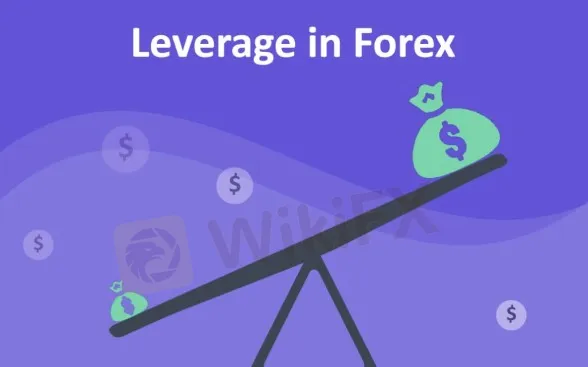简体中文
繁體中文
English
Pусский
日本語
ภาษาไทย
Tiếng Việt
Bahasa Indonesia
Español
हिन्दी
Filippiiniläinen
Français
Deutsch
Português
Türkçe
한국어
العربية
WikiFX Education: How to Take Advantage of the Forex Leverage?
Abstract:The following article describes the risks of high leverage in the forex market and summarizes ways to offset risky leverage levels.

To understand how to trade Forex, we need to have a detailed understanding of the economic and political conditions of each country, the global macroeconomy, and the impact of market volatility on a particular market. But the truth is that it is not usually the economy or global financial fluctuations that confuse Forex traders. Rather, a lack of basic knowledge of how to use leverage is often the root cause of trading losses
According to statistics from the largest forex brokers, most retail forex clients are losing money. The misuse of leverage is often cited as the cause of these losses. The following article describes the risks of high leverage in the forex market and summarizes ways to offset risky leverage levels.
High Leverage Gets Risky
Leverage refers to the process by which an investor borrows money to invest or buy something. In forex trading, funds are usually obtained from a broker. Although Forex traders can borrow large amounts of money based on initial margin requirements, they can make more profit from successful trades.
In the past, many brokers were able to offer high leverage ratios of up to 400:1. This meant that by depositing as little as $250, a trader could control approximately $100,000 in the global foreign exchange market. However, in 2010 financial regulations limited the leverage offered by brokers to U.S. traders to 50:1 (which is still quite large). This means that with the same $250 deposit, a trader can control $12,500 of currency.
How to Choose the Right Level of Leverage?
Before choosing a leverage level, investors should review the generally accepted rules. The three simplest rules of leverage are:
1. Keep the leverage level low;
2. Use a stop loss to reduce downside and protect capital;
3. Limit the capital of each position to 1% to 2% of the total trading capital.
Forex traders should choose the level of leverage they feel most comfortable with. If you are conservative and don't like to take risks, or if you are still learning how to trade currencies, then a lower leverage ratio (e.g. 5:1 or 10:1) may be more appropriate.
Trailing or limited stops provide a reliable way for investors to cut their losses if a trade goes wrong. By limiting stops, investors can ensure that they can continue to learn how to trade currencies, but they can limit potential losses if the trade fails. These stops are also important because they help reduce trading emotions and allow individuals to leave the trading desk without emotion.
Choosing the appropriate level of Forex leverage depends on the trader's experience, risk tolerance and comfort level in operating in the global currency markets. New traders should familiarize themselves with the terminology and remain conservative in learning how to trade and gain experience. Using stops, keeping positions small and limiting the amount of capital in each position is a good start to learning proper leverage management practices.
More Forex Knowledge at WikiFX
WikiFX is a global broker regulatory inquiry app that holds information of over 35,000 forex brokers in collaboration with 30 national regulators. Here, traders can find verified details of a certain forex broker before engaging with them. In addition to this, you can also see more forex news. Visit WikiFX's official website at www.wikifx.com.

Alternatively, download the free WikiFX app on Google Play/App Store.

Disclaimer:
The views in this article only represent the author's personal views, and do not constitute investment advice on this platform. This platform does not guarantee the accuracy, completeness and timeliness of the information in the article, and will not be liable for any loss caused by the use of or reliance on the information in the article.
Read more

WikiEXPO Becomes Partner of the Liberland Government
Wiki Finance EXPO is honored to announce a partnership with the Free Republic of Liberland. This collaboration will further advance global dialogue on financial innovation and decentralized technology, bringing cutting-edge insights and industry opportunities to participants.

Key Risks and Downsides of Forex Trading Explained
Discover the key risks and downsides of forex trading, including market volatility, leverage dangers, and emotional challenges. Learn how to trade wisely.

eToro Review 2025: Trading Accounts & Withdrawals to Explore
eToro is an intuitive online trading platfrom that features social trading solutions, a unique being in the industry, with great popularity among both novices and seasoned traders. On the eToro platform, traders can trader over greater amount of stocks and ETFs with zero commission charged,anencouraging feature was later adopted by many of its competitors. 55 currencies can be traded, with spreads starting at 1 pip (typically on the euro/usd pair), not that competitive, and a trading fee of 1% trading fee of 1% applies to crypto trading. Opening a trading account is quite easy for investors, and demo accounts (funded with $100,000 virtual money) are also provided to enhance beginners' trading courage. However, a major disencouraging point is that this broker has a more limited platform options, only eToro proprietary trading platform and MetaTrader (MT4) supported.

EBSWARE Prop Launches Forex Trading Tournaments for Brokers
EBSWARE Prop introduces a white-label solution for Forex brokers, featuring trading tournaments, multi-platform integration, and affiliate systems to boost user engagement.
WikiFX Broker
Latest News
EBSWARE Prop Launches Forex Trading Tournaments for Brokers
Key Risks and Downsides of Forex Trading Explained
How a Crypto Scam Cost Company Manager RM2.56 Million
TD Bank to Sell $14.9 Billion Schwab Stake, Repurchase Shares
Warning Against Agra Markets: Stay Cautious!
Scam Exposed: GlobTFX Deceives Another Investor
Trump tariffs: Retaliate or negotiate - what will US partners do next?
Hacker Who Breached SEC Account and Falsely Announced Bitcoin ETF Approval Faces Trial
Oil Prices Fluctuate as Iran and Trump Clash!
Best Regulated Forex Brokers Offering Daily Trading Signals
Currency Calculator



